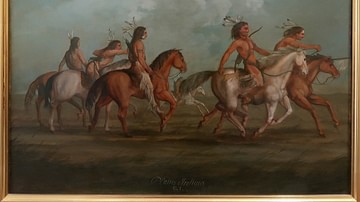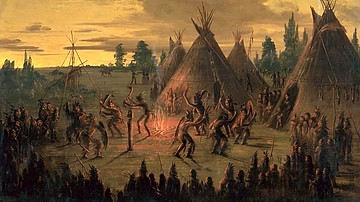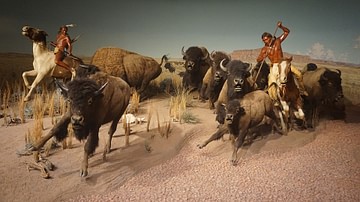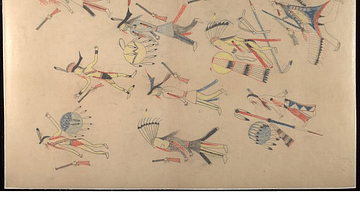The Brave Who Went on the Warpath Alone and Won the Name of the Lone Warrior is a Sioux tale in the tradition of the hero's journey in which a young person overcomes seemingly impossible challenges and is recognized as a great champion and leader of his or her people.
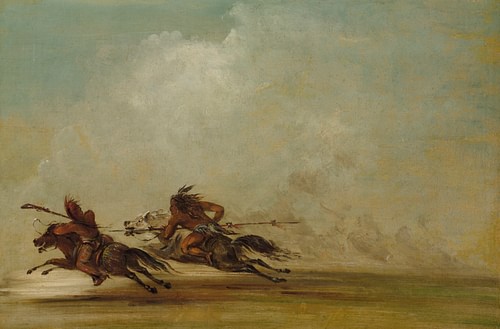
The story, in fact, exemplifies the motif of the hero's journey in which the hero (most often male), who is usually struggling with internal or external challenges (or both) when the tale begins, embarks on an adventure and returns transformed, having achieved self-actualization, and bringing back with him something of transformative power that benefits his people and elevates his status. The hero's journey is among the most popular story patterns in history and, in the present era, is most widely recognized as the underlying form of the Star Wars franchise.
Native American Values
The story illustrates not only the values of the Sioux but those of all the Native American nations of the Plains Indians culture, including the value of horses, the importance of a male proving himself in single combat or battle as a show of character, the values of resourcefulness and personal courage, and how one is rewarded for perseverance and endurance under trying circumstances. The tale also highlights another important aspect of Native American culture: the connection between the land and the people. The original audience of the tale would have understood the land described in the story as the same they were living on, connecting them to the past, to the events of the narration, and to the values the story highlights.
Among these values are the horses at the center of the tale, which the young hero needs to take to prove himself. Horses were introduced into North America by the Spanish in the 16th century and were already a part of the culture of the Plains Indians by c. 1700. The so-called 'horse culture' that developed during this time recognized the horse as a status symbol, either for an individual or a tribal nation, and horses came to represent wealth and power. The horse served in transportation, hunting, warfare, and trade, and, by the 19th century, was an integral aspect of the lives of the Plains Indians, including the Sioux, who became famous as great masters of the horse. Stealing horses from another tribe increased one's own prestige and that of one's people by showing one's personal strength and cunning in depriving an enemy of an important resource.
In the following story, a poor young man without prospects, rejected by his peers, leaves his village to prove himself by stealing horses from the enemies of his people and bringing back the scalps of those he defeats in combat. The tension of the story, as in any hero's journey tale, rises as the young man's challenges increase, and the audience waits to see whether he will succeed or fail. As with all Native American stories, there is no date attached to the tale as it would have been transmitted orally by the storytellers of the tribe, passed down from generation to generation, until recorded by white settlers in the 19th and early 20th centuries. This version of the story comes from Myths and Legends of the Sioux (1916) by Marie L. McLaughlin, a part-Sioux who recorded their stories to preserve them.
Text
There was once a young man whose parents were not overburdened with the riches of this world and, consequently, could not dress their only son in as rich a costume as the other young men of the tribe and, on account of not being so richly clad as they, he was looked down upon and shunned by them. He was never invited to take part in any of their sports; nor was he ever asked to join any of their war parties.
In the village lived an old man with an only daughter. Like the other family, they were poor, but the daughter was the belle of the tribe. She was the most sought after by the young men of the village, and warriors from tribes far distant came to press their suit at winning her for their bride. All to no purpose; she had the same answer for them as she had for the young men of the village.
The poor young man was also very handsome despite his poor clothes, but having never killed an enemy, nor brought home any enemies' horses, he was not (according to the rules) allowed to make love to any young or old woman. He tried in vain to join some of the war parties, that he might get the chance to win his spurs as a warrior. To all his pleadings, came the same answer: "You are not fit to join a war party. You have no horses, and if you should get killed, our tribe would be laughed at and be made fun of as you have such poor clothes, and we don't want the enemy to know that we have any one of our tribe who dresses so poorly as you do."
Again, and again, he tried different parties, only to be made fun of and insulted.
One night, he sat in the poor teepee of his parents. He was in deep study and had nothing to say. His father, noticing his melancholy mood, asked him what had happened to cause him to be so quiet, as he was always of a jolly disposition. The son answered and said:
"Father, I am going on the warpath alone. In vain I have tried to be a member of one of the war parties. To all of my pleadings, I have got nothing but insults in return."
"But, my son, you have no gun or ammunition. Where can you get any and how can you get it? We have nothing to buy one for you with," said the father.
"I don't need any weapons. I am going to bring back some of the enemies' horses, and I don't need a gun for that."
Early the next morning (regardless of the old couple's pleadings not to go unarmed) the young man left the village and headed northwest, the direction always taken by the war parties.
For ten days he traveled without seeing any signs of a camp. The evening of the tenth day, he reached a very high butte, thickly wooded at the summit. He ascended this butte, and as he sat there between two large boulders, watching the beautiful rays of the setting sun, he was suddenly startled to hear the neigh of a horse. Looking down into the beautiful valley which was threaded by a beautiful creek fringed with timber, he noticed close to the base of the butte upon which he sat, a large drove of horses grazing peacefully and quietly. Looking closer, he noticed at a little distance from the main drove, a horse with a saddle on his back. This was the one that had neighed, as the drove drifted further away from him. He was tied by a long lariat to a large sage bush.
Where could the rider be, he said to himself. As if in answer to his question, there appeared, not more than twenty paces from him, a middle-aged man coming up through a deep ravine. The man was evidently in search of some kind of game, as he held his gun in readiness for instant use, and kept his eyes directed at every crevice and clump of bush. So intent as he on locating the game he was trailing, that he never noticed the young man who sat like a statue not twenty paces away. Slowly and cautiously the man approached, and when he had advanced to within a few paces of the young man, he stopped and, turning around, stood looking down into the valley.
This was the only chance that our brave young friend had. Being unarmed, he would stand no show if the enemy ever got a glimpse of him. Slowly and noiselessly, he drew his hunting knife (which his father had given him on his departure from home) and, holding it securely in his right hand, gathered himself and gave a leap which landed him upon the unsuspecting enemy's shoulders. The force with which he landed on the enemy caused him to lose his hold on his gun and it went rattling down the chasm, forty feet below.
Down they came together, the young man on top. No sooner had they struck the ground than the enemy had out his knife, and then commenced a hand-to-hand duel. The enemy, having more experience, was getting the best of our young friend. Already our young friend had two ugly cuts, one across his chest and the other through his forearm.
He was becoming weak from the loss of blood and could not stand the killing pace much longer. Summoning all his strength for one more trial to overcome his antagonist, he rushed him toward the chasm and, in his hurry to get away from this fierce attack, the enemy stepped back one step too far, and down they both went into the chasm. Interlocked in each other's arms, they young man drove his knife into the enemy's side and when they struck the bottom, the enemy relaxed his hold and straightened out stiff and dead.
Securing his scalp and gun, the young man proceeded down to where the horse was tied to the sage bush, and then gathering the drove of horses, proceeded on his return to his own village. Being wounded severely, he had to ride very slowly. All the long hours of the night he drove the horses towards his home village.
In the meantime, those at the enemies' camp wondered at the long absence of the herder who was watching their drove of horses and, finally, seven young men went to search for the missing herder. All night long they searched the hillsides for the horses and herder, and when it had grown light enough in the morning, they saw by the ground where there had been a fierce struggle.
Following the tracks in the sand and leaves, they came to the chasm where the combatants had fallen over and there, lying on his back staring up at them in death, was their herder. They hastened to the camp and told what they had found. Immediately, the warriors mounted their war ponies (these ponies are never turned loose but kept tied close to the teepee of the owner), and, striking the trail of the herd driven off by our young friend, they urged forth their ponies and were soon far from their camp on the trail of our young friend.
All day long they traveled on his trail and, just as the sun was sinking, they caught sight of him driving the drove ahead over a high hill. Again, they urged forth their tired ponies. The young man, looking back along the trail, saw some dark objects coming along and, catching a fresh horse, drove the rest ahead at a great rate. Again, all night he drove them, and when daylight came, he looked back (from a high butte) over his trail and saw coming over a distant rise, two horsemen. These two undoubtedly rode the best ponies, as he saw nothing of the others.
Driving the horses into a thick belt of timber, he concealed himself close to the trail made by the drove of horses and lay in ambush for the two daring horsemen who had followed him so far. Finally, they appeared on the butte from where he had looked back and saw them following him. For a long time, they sat there scouring the country before them in hopes that they might see some signs of their stolen horses. Nothing could they see. Had they but known, their horses were but a few hundred yards from them, but the thick timber securely hid them from view.
Finally, one of them arose and pointed to the timber. Then, leaving his horse in charge of his friend, he descended the butte and followed the trail of the drove to where they had entered the timber. Little did he think that he was standing on the brink of eternity. The young man hiding not more than a hundred yards from him could have shot him there where he stood but, wanting to play fair, he stepped into sight. When he did, the enemy took quick aim and fired. He was too hasty. Had he taken more careful aim, he might have killed our young friend, but his bullet whizzed harmlessly over the young man's head and buried itself in a tree.
The young man took good aim and fired. The enemy threw up both his hands and fell forward on his face. The other one on the hill, seeing his friend killed, hastily mounted his horse and, leading his friend's horse, made rapidly off down the butte in the direction from whence he had come. Waiting for some time to be sure the one who was alive did not come up and take a shot at him, the young man finally advanced upon the fallen enemy and, securing his gun, ammunition, and scalp, went to his horse and drove the herd on through the woods and, crossing a long, flat prairie, ascended a long chain of hills and sat looking back along his trail in search of any of the enemy who might continue to follow him.
Thus he sat until the long shadows of the hills reminded him that it would soon be sunset and, as he must get some sleep, he wanted to find some creek bend where he could drive the bunch of ponies and feel safe as to their not straying off during the night. He found a good place for the herd and, catching a fresh horse, he picketed him close to where he was going to sleep, and wrapping himself in his blanket, was soon fast asleep. So tired and sleepy was he that a heavy rain which had come up during the night soaked him through and through, but he never awakened until the sun was high in the east.
He awoke and, going to the place where he had left the herd, he was glad to find them all there. He mounted his horse and started his herd homeward again. For two days he drove them, and on the evening of the second day, he came in sight of his village.
The older warriors, when they had heard of the young man going on this trip alone and unarmed, had told the parents to go into mourning for their son, as he would never come back alive. When the people of the village saw this large drove of horses advancing towards them, they at first thought it was a war party of the enemy and so the head men called the young warriors together and fully prepared for a great battle. They advanced upon the supposed enemy. When they got close enough to discern a lone horseman driving this large herd, they surrounded the horses and the lone warrior, and brought him triumphantly into the village. On arriving in the village, the horses were counted, and the number counted up to one hundred and ten head.
Being considered eligible now to pay his respects to any girl who took his fancy, Lone Warrior at once went to the camp of the beautiful girl of the tribe and, as he was always her choice, she at once consented to marry him. The news spread through the village that Lone Warrior had won the belle of the nation for his bride and this, with the great feat which he had accomplished alone in killing two enemies and bringing home a great herd of horses, raised him to the rank of chief, which he faithfully filled to the end of his days. And, many times, he had to tell his grandchildren the story of how he got the name of Lone Warrior.
